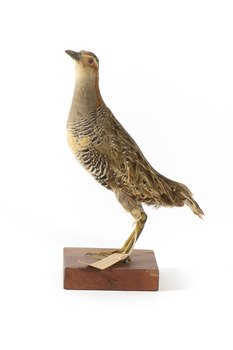Historical information
The buff-banded rail is a medium-sized bird in the rail family, Rallidae, known for its striking plumage and strong dispersal abilities. This species includes multiple subspecies found across Australasia and the southwest Pacific, with populations in the Philippines, where it is called tikling, and New Guinea, Australia, New Zealand, where it is referred to as the banded rail or moho-pererū in Māori—and various smaller islands.
This specimen was misidentified as an Australian Spotted Crake in original catalogue records and is part of a collection of almost 200 animal specimens that were originally acquired as skins from various institutions across Australia, including the Australian Museum and the National Museum of Victoria, as well as individuals such amateur anthropologist Reynell Eveleigh Johns between 1860-1880. These skins were then mounted by members of the Burke Museum Committee and put-on display in the formal space of the Museum’s original exhibition hall where they continue to be on display. This display of taxidermy mounts initially served to instruct visitors to the Burke Museum of the natural world around them, today it serves as an insight into the collecting habits of the 19th century.
Significance
This specimen is part of a significant and rare taxidermy mount collection in the Burke Museum. This collection is scientifically and culturally important for reminding us of how science continues to shape our understanding of the modern world. They demonstrate a capacity to hold evidence of how Australia’s fauna history existed in the past and are potentially important for future environmental research.
This collection continues to be on display in the Museum and has become a key part to interpreting the collecting habits of the 19th century.
Physical description
This specimen is a small, stocky bird with yellow legs and bill. The Buff-banded Rail has grey colouring on its neck and an orange on the nape of its neck. The torso and rear are striped with black and grey/cream colours and have white spots along the rear. The specimen has brown feathers on the wings. It stands on a wooden platform in a standing position with a paper identification tag tied around its left leg.
Inscriptions & markings
19c Spotted Water Crake. See Catalogue, Page, 35.
Subjects
References
- Birdlife
- Birds in backyards
- Ebird.org
- Menkhorst, P., Rogers, D., Clarke, R., Davies, J., Marsack, P. & Franklin, K. 2019, The Australian Bird Guide, CSIRO Publishing, Clayton, Victoria.
























